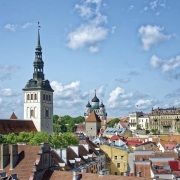How did the Cold War start?
What is the Cold War? The Cold War is an ideological conflict between the two superpowers, USA and USSR in the post-WWII period. This conflict was the result of different contributing factors that shaped the perceptions towards each other’s actions, resulting in heightened sense of distrust and suspicion. In this article, we will examine several key factors that contributed to the outbreak of the Cold War.
Topic of Study [For H2 and H1 History Students]: Paper 1: Understanding the Cold War (1945-1991) Section A: Source-based Case Study Theme I Chapter 1: Emergence of Bipolarity after the Second World War
1. Ideological Differences To understand how the Cold War broke out, it is important to understand why the mutually-incompatible ideologies of the two countries became the root cause of the conflict.
After the Russian Revolution of 1917, the communists rose to power in the Soviet Union. Communism is socio-political philosophy that advocates the common ownership of the means of production. On the other hand, the United States embraced the ideology of Capitalism and Democracy. In contrast to communism, capitalism focuses on the private ownership of the means of production and profit is the main motivation for individuals to work and produce goods and services. Also, democracy empowers the citizens with the right to vote and elect representatives that form the government. In view of these ideological differences, it is clear that there will be stark contrasts in how the US and USSR conducted their foreign policies in Europe after the World War Two, which set the stage for the start of the Cold War.2. Perceived Ideological Expansionism The diametrically opposed ideologies can be better understood by how US and USSR implemented their foreign policies, following the discussions made during the Yalta Conference in February 1945. During the Conference, USA, USSR and UK engaged in discussions on the post-war reorganization of Europe and Germany. Amidst the discussions, the Declaration of Liberated Europe was formed as a promise to allow the European citizens to “create democratic institutions of their own choice”.
However, Stalin held differing interpretations of the agreements made in the Yalta Conference. USA perceived Stalin as being responsible for the establishment of pro-Soviet Communist governments in Europe (e.g. Poland, Bulgaria and Hungary). As such, the fear of Soviet communist expansion prompted USA to introduce the Truman Doctrine in 1947, as a guiding principle to ‘contain Communism’. Subsequently, USA was involved more actively in Europe to stem the tide of Communism.
3. Perceived Economic Imperialism Given that the World War Two had ravaged Europe severely, USA embarked on an economic initiative to provide financial assistance to rebuild Western European economies. This 1947 initiative was also known as the ‘Marshall Plan‘, which was named after US Secretary of State George Marshall. Over $13 billion in economic aid was distributed to Western European countries.
However, USSR interpreted these acts with great suspicion as the provision of American aid and assistance would create an anti-Soviet bloc. In response, USSR developed a similar economic initiative, known as the ‘Molotov Plan‘, which provided financial assistance to Eastern European countries, resulting in the creation of a pro-Soviet bloc. More importantly, USSR held the perception that it had to act swiftly to be free from ‘American economic imperialism’.4. What’s Next? Following a series of indirect exchanges between the two superpowers, Europe took centre-stage in marking the start of the Cold War. The outbreak of the Cold War can be observed by the division of Europe ideologically and economically, as explained and illustrated in the above points.
How to study the Cold War and answer the Source-Based Case Study Questions? Now that we have examined the key events and considerations that contributed to the start of the Cold War, you can reinforce your learning by attempting practice questions on your own. Pay attention to the sources. Pick out the key words or events that were mentioned in the sources and draw out the implications to answer the questions. Avoid spending too much time on reading notes (and additional readings, if any) as exam-oriented knowledge application skills are developed only through actual writing and thinking.
Here are some questions for you to get you started on your revision for the Cold War topic: – What were the evidences that fueled USA’s perceived fear of Soviet Communist expansionism? – What were Stalin’s justifications for the creation of a pro-Soviet bloc in Eastern Europe? – How did the Berlin Blockade of 1948 contributed to the start of the Cold War? [to be covered in our lessons] The H2 and H1 History Tuition feature online discussion and writing practices to enhance your knowledge application skills. Get useful study notes and clarify your doubts on the subject with the tutor. You can also follow our Telegram Channel to get useful updates. We have other JC tuition classes, such as JC Math Tuition and JC Chemistry Tuition. For Secondary Tuition, we provide Secondary English Tuition, Secondary Math tuition, Secondary Chemistry Tuition, Social Studies Tuition, Geography, History Tuition and Secondary Economics Tuition. For Primary Tuition, we have Primary English, Math and Science Tuition. Call 9658 5789 to find out more.










